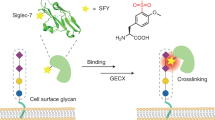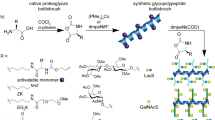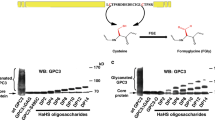Abstract
Metabolic 'oligosaccharide engineering' methods based on N-acetyl-D-mannosamine (ManNAc) analogs allow the glycocalyx of living cells to be remodeled1,2,3. Herein we report the analog Ac5ManNTGc (1) that enables thiols to be expressed in surface sialic acids. By locating this versatile functional group on the outer periphery of normally nonadhesive human Jurkat cells, we obtained spontaneous cell-cell clustering and attachment to complementary maleimide-derivatized substrates. When analyzed in human embryoid body–derived (hEBD) stem cells, Ac5ManNTGc induced β-catenin expression and altered cell morphology, consistent with neuronal differentiation. Notably, these effects were modulated by the growth substrate of the cells, with a stronger response observed on a gold surface than on glass. Together, these results establish sugar analogs as small-molecule tools for tissue engineering by providing a method for attaching cells to scaffolds via their surface carbohydrates as well as offering a means to influence stem cell fates.
This is a preview of subscription content, access via your institution
Access options
Subscribe to this journal
Receive 12 print issues and online access
$259.00 per year
only $21.58 per issue
Buy this article
- Purchase on Springer Link
- Instant access to full article PDF
Prices may be subject to local taxes which are calculated during checkout





Similar content being viewed by others
References
Kayser, H. et al. Biosynthesis of a nonphysiological sialic acid in different rat organs, using N-propanoyl-D-hexosamines as precursors. J. Biol. Chem. 267, 16934–16938 (1992).
Mahal, L.K., Yarema, K.J. & Bertozzi, C.R. Engineering chemical reactivity on cell surfaces through oligosaccharide biosynthesis. Science 276, 1125–1128 (1997).
Keppler, O.T., Horstkorte, R., Pawlita, M., Schmidt, C. & Reutter, W. Biochemical engineering of the N-acyl side chain of sialic acid: biological implications. Glycobiology 11, 11R–18R (2001).
Yarema, K.J., Mahal, L.K., Bruehl, R.E., Rodriguez, E.C. & Bertozzi, C.R. Metabolic delivery of ketone groups to sialic acid residues. Application to cell surface glycoform engineering. J. Biol. Chem. 273, 31168–31179 (1998).
Nakashima, I. et al. Redox-linked signal transduction pathways for protein tyrosine kinase activation. Antioxid. Redox Signal. 4, 517–531 (2002).
Saxon, E. & Bertozzi, C.R. Cell surface engineering by a modified Staudinger reaction. Science 287, 2007–2010 (2000).
Hou, D.-X., Arimura, M., Fukuda, M., Oka, T. & Fujii, M. Expression of cell adhesion molecule and albumin genes in primary culture of rat hepatocytes. Cell Biol. Int. 25, 239–244 (2001).
De Bank, P.A., Kellam, B., Kendall, D.A. & Shakesheff, K.M. Surface engineering of living myoblasts via selective periodate oxidation. Biotechnol. Bioeng. 81, 800–808 (2003).
Collins, B.E., Fralich, T.J., Itonori, S., Ichikawa, Y. & Schnaar, R.L. Conversion of cellular sialic acid expression from N-acetyl- to N-glycolylneuraminic acid using a synthetic precursor, N-glycolylmannosamine pentaacetate: inhibition of myelin-associated glycoprotein binding to neural cells. Glycobiology 10, 11–20 (2000).
Ratner, D.M. et al. Probing protein–carbohydrate interactions with microarrays of synthetic oligosaccharides. ChemBioChem 5, 379–383 (2004).
Thorsen, T., Maerkl, S.J. & Quake, S.R. Microfluidic large scale integration. Science 298, 580–584 (2002).
Langer, R. & Tirrell, D.A. Designing materials for biology and medicine. Nature 428, 487–492 (2004).
Edwards, B.E., Gearhart, J.D. & Wallach, E.E. The human pluripotent stem cell: impact on medicine and society. Fertil. Steril. 74, 1–7 (2000).
Shamblott, M.J. et al. Human embryonic germ cell derivatives express a broad range of developmentally distinct markers and proliferate extensively in vitro. Proc. Natl. Acad. Sci. USA 98, 113–118 (2001).
Jaiswal, J.K., Goldman, E.R., Mattoussi, H. & Simon, S. Use of quantum dots for live cell imaging. Nat. Methods 1, 73–78 (2004).
Martin, M.J., Muotri, A., Gage, F. & Varki, A. Human embryonic stem cells express an immunogenic nonhuman sialic acid. Nat. Med. 11, 228–232 (2005).
Teo, J.-L., Ma, H., Nguyen, C., Lam, C. & Kahn, M. Specific inhibition of CBP/β-catenin interaction rescues defects in neuronal differentiation caused by a presenilin-1 mutation. Proc. Natl. Acad. Sci. USA 102, 12171–12176 (2005).
Teo, R., Möhrlen, F., Plickert, G., Müller, W.A. & Frank, U. An evolutionary conserved role of Wnt signaling in stem cell fate decision. Dev. Biol. 289, 91–99 (2006).
Kasai, M., Satoh, K. & Akiyama, T. Wnt signaling regulates the sequential onset of neurogenesis and gliogenesis via induction of BMPs. Genes Cells 10, 777–783 (2005).
Ille, F. & Sommer, L. Wnt signaling: multiple functions in neural development. CMLS Cell. Mol. Life Sci. 62, 1100–1108 (2005).
Liu, J. et al. A small-molecule agonist of the Wnt signaling pathway. Angew. Chem. Int. Edn. Engl. 44, 1987–1990 (2005).
Turner, N., Armitage, M., Butler, R. & Ireland, G. An in vitro model to evaluate cell adhesion to metals used in implantation shows significant differences between palladium and gold or platinum. Cell Biol. Int. 28, 541–547 (2004).
Barbosa, J.N., Barbosa, M.A. & Águas, A.P. Inflammatory responses and cell adhesion to self-assembled monolayers of alkanethiolates on gold. Biomaterials 25, 2557–2563 (2004).
Yousaf, M.N., Houseman, B.T. & Mrksich, M. Using electroactive substrates to pattern the attachment of two different cell populations. Proc. Natl. Acad. Sci. USA 98, 5992–5996 (2001).
Chen, C.S., Mrksich, M., Huang, S., Whitesides, G.M. & Ingber, D.E. Geometric control of cell life and death. Science 276, 1425–1428 (1997).
Vats, A., Bielby, R., Tolley, N., Nerem, R. & Polak, J. Stem cells. Lancet 366, 592–602 (2005).
Orner, B.P., Derda, R., Lewis, R.L., Thomson, J.A. & Kiessling, L.L. Arrays for the combinatorial exploration of cell adhesion. J. Am. Chem. Soc. 126, 10808–10809 (2004).
Wichterle, H., Lieberam, I., Porter, J.A. & Jessell, T.M. Directed differentiation of embryonic stem cells into motor neurons. Cell 110, 385–397 (2002).
Ding, S. & Schultz, P.G. A role for chemistry in stem cell biology. Nat. Biotechnol. 22, 833–840 (2004).
Lemieux, G.A. & Bertozzi, C.R. Modulating cell surface immunoreactivity by metabolic induction of unnatural carbohydrate antigens. Chem. Biol. 8, 265–275 (2001).
Acknowledgements
We are grateful to K. Konstantopoulos for flow cytometer access, P. Pawar for technical assistance in FACS experiments, J.D. Gearhart and M.J. Shamblott for the kind gift of EBD LVEC cells, T.H. Wang for the kind gift of QD655-streptavidin conjugate, and J.M. McCaffery and E. Perkins of the Integrated Imaging Facility (Johns Hopkins University Department of Biology) for help with confocal microscopy. This work was supported by funding from the Arnold and Mabel Beckman Foundation, the US National Institutes of Health (1R01CA112314-01A1) and the National Science Foundation (QSB-0425668).
Author information
Authors and Affiliations
Corresponding author
Ethics declarations
Competing interests
The authors declare no competing financial interests.
Supplementary information
Supplementary Fig. 1
Concentration and time course of CST expression. (PDF 72 kb)
Supplementary Fig. 2
Dose dependency of CST expression on 1. (PDF 230 kb)
Supplementary Scheme 1
Synthesis of 1. (PDF 52 kb)
Supplementary Scheme 2
Synthesis of 2. (PDF 50 kb)
Supplementary Scheme 3
Labeling of cell-surface thiols. (PDF 51 kb)
Supplementary Scheme 4
Effect of TCEP treatment. (PDF 43 kb)
Rights and permissions
About this article
Cite this article
Sampathkumar, SG., Li, A., Jones, M. et al. Metabolic installation of thiols into sialic acid modulates adhesion and stem cell biology. Nat Chem Biol 2, 149–152 (2006). https://doi.org/10.1038/nchembio770
Received:
Accepted:
Published:
Issue Date:
DOI: https://doi.org/10.1038/nchembio770
This article is cited by
-
Exploiting metabolic glycoengineering to advance healthcare
Nature Reviews Chemistry (2019)
-
On the use of abiotic sialic acids to attenuate cell inflammation
Scientific Reports (2018)
-
A library of chemically defined human N-glycans synthesized from microbial oligosaccharide precursors
Scientific Reports (2017)
-
Vimentin is important in the neural differentiation of PC12 cells promoted by sialylation
Glycoconjugate Journal (2017)
-
Metabolic glycoengineering bacteria for therapeutic, recombinant protein, and metabolite production applications
Glycoconjugate Journal (2015)



